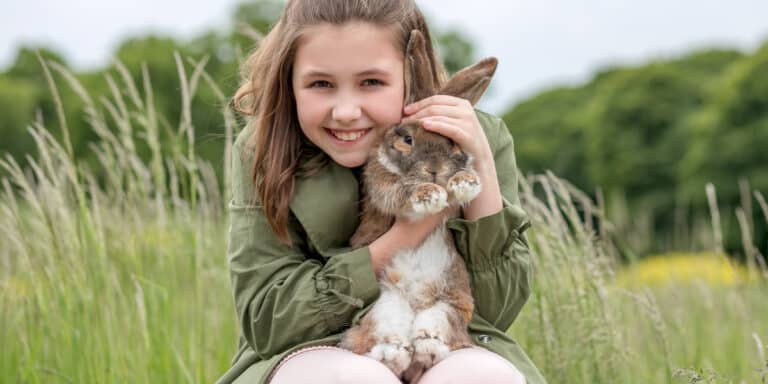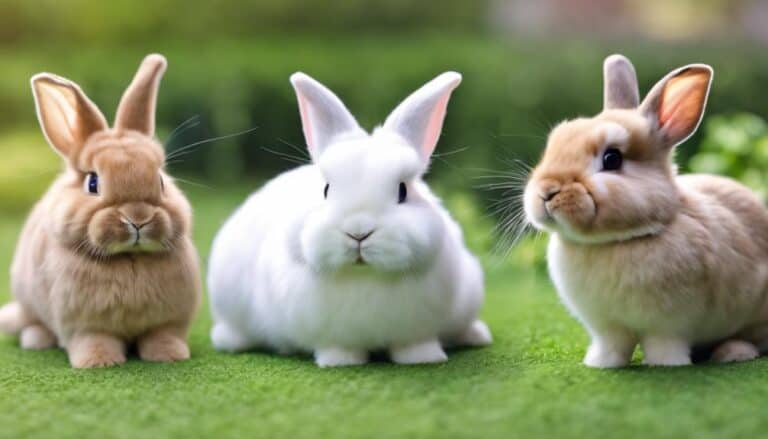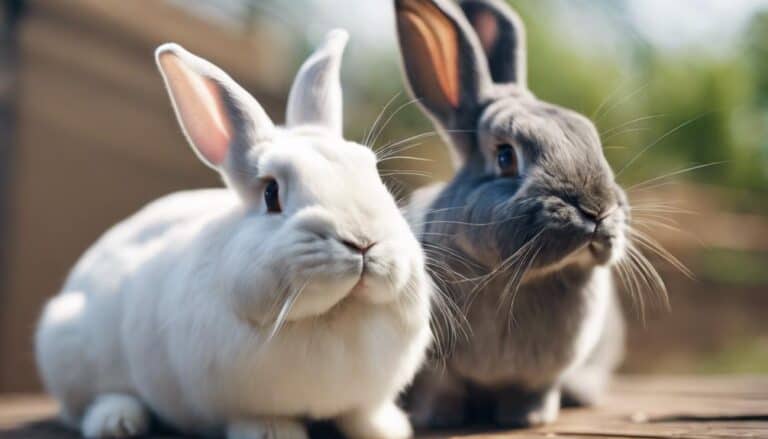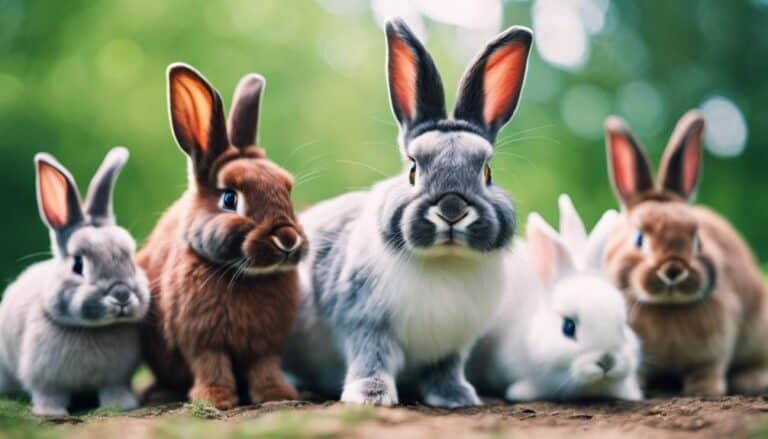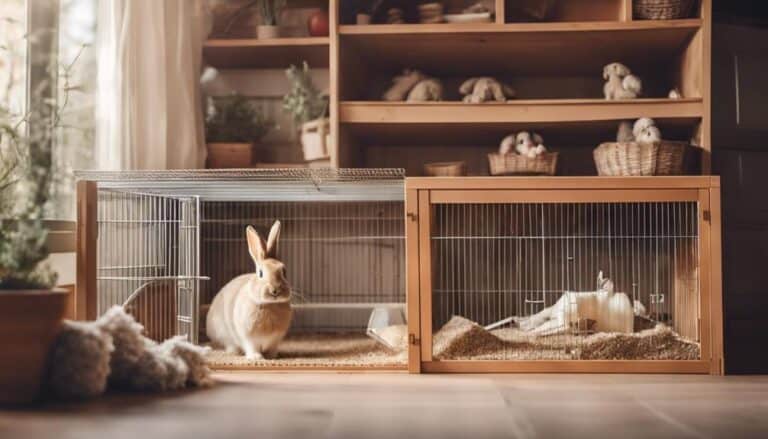If you've ever wondered why certain bunny breeds, like the French Lop Rabbit, boast long, floppy ears, there's more to it than meets the eye.
These distinctive ears serve a crucial purpose beyond merely enhancing their adorable appearance.
By understanding the evolutionary rationale behind these elongated auditory appendages, you'll gain insight into the fascinating adaptations that have enabled rabbits to thrive in diverse environments.
Explore the intriguing world of rabbit biology and behavior to uncover the secrets behind their iconic long ears.
Contents
- 1 Key Takeaways
- 2 Unique Bunny Breeds With Long Ears
- 3 Lop Eared Rabbits Explained
- 4 Anatomy of Long Bunny Ears
- 5 Health Considerations for Ear Care
- 6 Understanding Rabbit Body Language
- 7 Notable Bunny Breeds With Long Ears
- 8 Implications of Long Ears in Rabbits
- 9 Long Ears and Rabbit Genetics
- 10 Frequently Asked Questions
- 11 Do Bunny Breeds with Long Ears Have a Specific Pattern?
- 12 Conclusion
Key Takeaways
- Long ears in bunny breeds aid in thermoregulation and predator detection for enhanced survival.
- Genetic factors and selective breeding influence ear length diversity in rabbit breeds.
- Long ears improve auditory capabilities, allowing rabbits to detect sounds over long distances.
- Long ears can predispose rabbits to health issues like infections and trauma due to their structure.
Unique Bunny Breeds With Long Ears
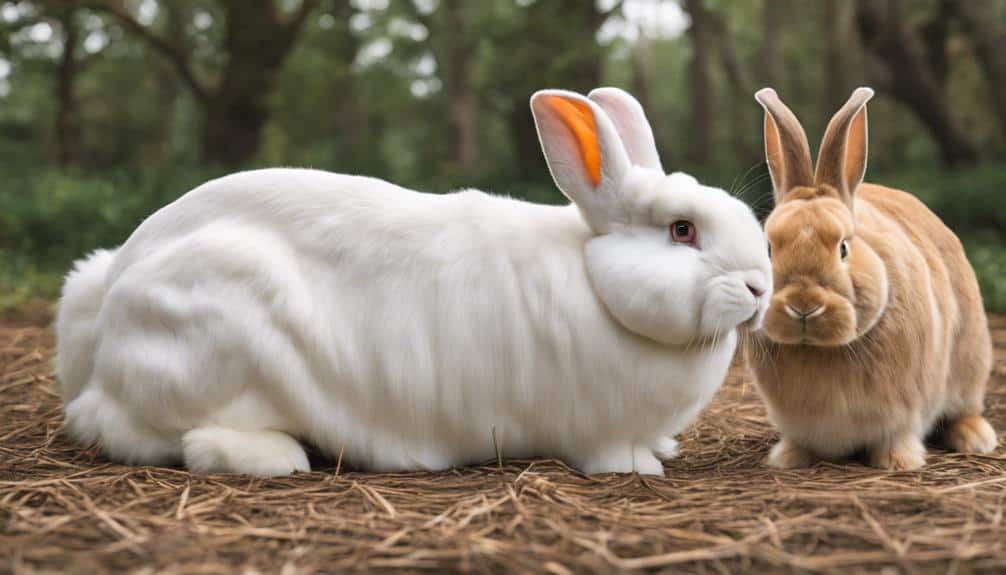
Discussing unique bunny breeds with long ears opens up a fascinating exploration into the genetic and physical characteristics that distinguish these extraordinary rabbits. Among these breeds, English Lop rabbits stand out for their exceptionally long ears, which can reach a minimum of 21 inches in length. The lop-eared condition seen in English Lops is controlled by multiple genes and arises from a deficiency in cartilage development.
The exaggerated ear size in English Lops not only adds to their distinctive appearance but also poses certain risks. These rabbits are more prone to ear trauma, infections, and even frostbite due to their elongated ears. Additionally, selective breeding has caused their ears to hang loosely and close to the body, affecting their agility and mobility.
It is essential to understand that all English Lops are affected by the lop-eared condition, which can lead to discomfort, pain, and chronic issues. Careful consideration and specialized care are necessary to safeguard the well-being of these unique bunny breeds with exceptionally long ears.
Lop Eared Rabbits Explained
Lop eared rabbits exhibit distinctive physical characteristics that impact their ability to regulate body temperature and hear effectively due to the drooping nature of their ears. The lop ears, a genetic mutation, can hinder thermoregulation since rabbits dissipate heat through their ears. This can pose a challenge for lop eared rabbits, especially in hot climates, as they may struggle to cool down efficiently. Additionally, the drooping ears can obstruct sound waves, affecting their auditory capabilities.
Although breeding for lop ears is uncommon in the wild, it's prevalent in pet breeds due to their amiable nature. The different styles of ear carriage in lop eared rabbit breeds, such as full lop, half lop, oar lop, and horn lop, add to the diversity within this category. It's worth noting that regulations in various countries restrict ear length in lop rabbits to safeguard their health, with excessive ear length leading to disqualifications in rabbit shows. Understanding the implications of lop ears on thermoregulation and hearing is essential for responsible breeding practices and the overall well-being of these rabbit breeds.
Anatomy of Long Bunny Ears

Long bunny ears, characterized by their elongated structure and rich vascular network, serve important functions in thermoregulation and auditory perception in rabbits. When exploring the anatomy of long bunny ears, consider the following:
- Efficient Thermoregulation: Long bunny ears contain extensive blood vessels that help regulate body temperature. The increased surface area of the ears allows for better heat exchange, aiding rabbits in cooling down on hot days.
- Sound Detection and Direction: The outer ear, also known as the pinna, plays a vital role in detecting sound direction. This feature helps rabbits locate predators or prey and communicate with other rabbits. Additionally, the pinna assists in regulating body temperature by increasing blood flow to the ears when needed.
- Internal Structures for Hearing: Inside the long ears of rabbits, essential structures for hearing, balance, and orientation are housed. These structures enable rabbits to perceive and react to their environment accurately, contributing to their overall survival.
Understanding the intricate anatomy of long bunny ears sheds light on the remarkable adaptations that aid rabbits in thriving in diverse environments.
Health Considerations for Ear Care
When considering the health of bunny breeds with long ears, it's important to address specific points related to ear care.
Ear wax buildup needs regular monitoring and cleaning to prevent infections and maintain ear hygiene.
Implementing a routine for regular ear cleaning can greatly reduce the risk of health issues related to long ears.
Ear Wax Buildup
Regularly checking and cleaning your rabbit's ears is important to prevent the buildup of ear wax, which can lead to serious infections if left untreated. When ear wax accumulates in your rabbit's ear canal, it can cause painful crusting and discomfort. Here are some essential tips to help you maintain your rabbit's aural health:
- Gentle Cleaning: Use a vet-approved ear cleaner and cotton ball to gently wipe away any visible wax buildup.
- Regular Inspection: Check your rabbit's ears weekly for any signs of redness, swelling, or abnormal discharge.
- Consult a Vet: If you notice excessive wax buildup or any unusual symptoms, seek advice from a veterinarian promptly.
Ear Infection Prevention
To effectively prevent ear infections in rabbits with long ears, maintaining a routine of regular ear cleaning using a veterinarian-recommended solution is essential. Long-eared rabbits are more prone to infections due to their ear anatomy, which can trap moisture and debris. Cleaning their ears helps remove excess wax and dirt that could lead to infections.
Additionally, checking and trimming excess fur around the ears is vital to reduce the risk of moisture buildup. Monitoring your rabbit for signs of discomfort, head shaking, or discharge from the ears is important, as these could indicate an infection requiring veterinary attention.
Providing a clean living environment free of drafts, along with a proper diet and regular grooming, can further contribute to preventing ear infections in bunny breeds with long ears.
Regular Ear Cleaning
To guarantee high-quality health and prevent potential issues, maintaining a regular routine of gentle ear cleaning using veterinarian-recommended solutions is essential for rabbits with long ears due to their increased susceptibility to infections. When caring for your lop-eared bunny, pay special attention to their ear canals, as these breeds are more prone to developing ear problems.
Here are three important steps to think about when cleaning your rabbit's ears:
- Use specialized solutions or wipes designed for rabbits to gently clean their ears.
- Check the ears weekly for any signs of redness, swelling, discharge, or unusual odor.
- Avoid using hot water or harsh chemicals in the ear canal to prevent irritation and discomfort.
Regular and proper ear hygiene can help maintain the best ear health and prevent serious ear-related issues in your furry friend.
Understanding Rabbit Body Language
Understanding rabbit body language is essential for accurately interpreting their feelings and responses. Rabbit ears play a vital role in communication signals, with different positions indicating various emotional states.
When a rabbit lays back its ears gently, it signifies relaxation and contentment. Conversely, ears pulled back at a 45º angle suggest anger or a sense of threat. Confident rabbits typically have their ears up but not stiff, reflecting their comfort level in the environment.
If a rabbit is feeling curious or cautious, it may lean its ears forward or point them to show interest in its surroundings. By observing and understanding these ear positions, one can effectively interpret a rabbit's emotions and responses.
This knowledge allows for better communication and interaction with these small, sensitive creatures, enhancing the bond between humans and rabbits.
Notable Bunny Breeds With Long Ears
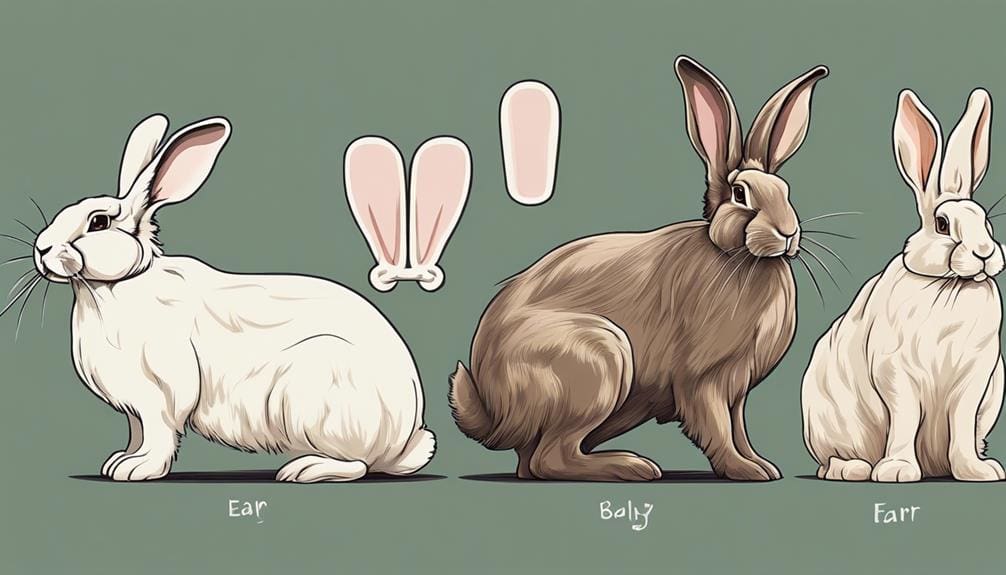
When considering notable bunny breeds with long ears, one can't overlook the distinctive features of English Lop rabbits. These rabbits exhibit an extreme ear size, reaching at least 21 inches from tip to tip. The width of their ears is approximately 1/4 of their total length, showcasing well-rounded and wide tips. English Lop rabbits have ears that hang loose and close to the body, carried low on the head without a noticeable crown. The ideal ear length for English Lop rabbits is as long as possible, with width in proportion and uniformly thick. These rabbits possess a lop-eared condition controlled by multiple genes, predisposing them to ear trauma, infections, and frostbite.
- English Lop rabbits have ears that can reach at least 21 inches long.
- The width of their ears is about 1/4 of their total length.
- English Lop rabbits exhibit a lop-eared condition controlled by multiple genes.
Implications of Long Ears in Rabbits
Long ears in rabbits play an important role in thermoregulation, facilitating heat exchange through extensive blood vessels and enhancing their auditory capabilities for predator detection over long distances. The elaborate network of blood vessels within the long ears helps regulate the rabbit's body temperature by dissipating heat in warm environments and conserving heat in colder conditions. This adaptation allows rabbits to maintain a stable internal temperature, essential for their overall health and well-being.
Additionally, the length of a rabbit's ears enables them to detect high-pitched sounds over long distances, aiding in predator detection and guaranteeing their survival in the wild. By rotating their long ears independently up to 270 degrees, rabbits can accurately pinpoint the source of a sound, further enhancing their ability to evade potential threats.
However, despite these advantages, rabbits with long ears may experience health issues such as infections, trauma, and discomfort due to the weight and size of their ears. Proper care and monitoring are essential to prevent such complications and safeguard the overall health of rabbits with long ears.
Long Ears and Rabbit Genetics
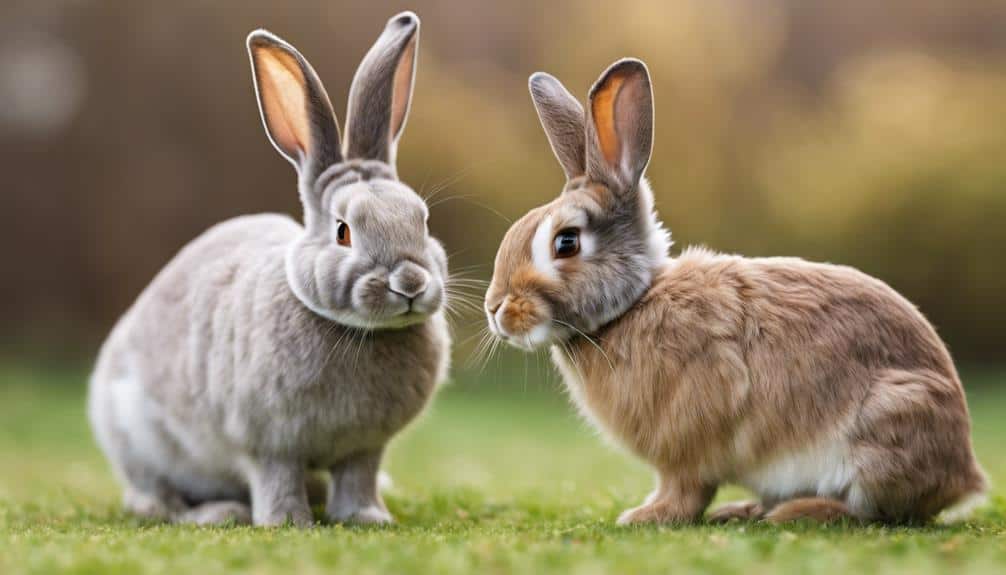
Long ears in rabbits are a result of the complex interplay of multiple genes governing ear size, particularly evident in lop-eared breeds.
The inheritance of ear length is likely polygenetic, contributing to the characteristic long ears seen in certain bunny breeds.
Evolutionarily, long ears may offer advantages such as enhanced hearing and thermoregulation, making them a desirable trait in specific environments.
Genetic Basis of Ears
The genetic regulation of ear size in rabbits involves the intricate interplay of multiple genes, contributing to the diverse range of ear sizes observed across different breeds. Some breeds have exaggerated ears due to specific genetic factors:
- Polygenetic Control: Multiple genes interact to determine the size of a rabbit's ears.
- Selective Breeding Impact: Over time, selective breeding has accentuated ear size in certain rabbit breeds.
- Distinctive Traits in English Lops: English Lop rabbits, known for their exceptionally long ears, showcase a polygenetic trait that influences their unique ear morphology.
Understanding these genetic foundations can assist breeders in making informed decisions to maintain or modify ear characteristics in specific rabbit breeds.
Inheritance of Ear Length
Understanding the genetic mechanisms that govern ear length in rabbits involves a complex interplay of multiple genes and selective breeding practices. Long ears are an inherited trait, with English Lop rabbits being a prime example of the extreme lengths achieved through selective breeding. While the polygenetic basis of ear size in rabbits remains uncertain, lop ears are often linked to a cartilage deficiency.
Selective breeding for exaggerated ear size raises welfare risks for rabbits, such as increased chances of trauma, infections, and frostbite. It's important to ponder the ethical implications of breeding practices that prioritize extreme ear size, as the resulting welfare risks can impact the overall well-being of these animals.
Evolutionary Advantage of Long Ears
Through an intricate interplay of genetic factors and selective breeding practices, the evolutionary advantage of long ears in certain bunny breeds becomes evident.
- Long ears provide enhanced thermoregulation by increasing the surface area for heat exchange, aiding rabbits in maintaining a stable body temperature.
- The evolutionarily advantageous long ears offer improved cooling in hot climates and better detection of predators, enhancing the survival chances of these bunny breeds.
- Genetic factors influence ear length in bunny breeds, with selective breeding contributing to the exaggeration of ear sizes over generations.
This unique adaptation not only showcases the diverse strategies animals employ for survival in different environments but also highlights the pivotal role of genetics and selective breeding in shaping physical characteristics like ear length in rabbits.
Frequently Asked Questions
Why Do Some Bunnies Have Long Ears?
Long ears in certain bunnies serve crucial roles like heat regulation, predator detection, and environmental monitoring. Their evolution reflects adaptation to varied climates. Genetics impact ear length, aiding in thermoregulation through blood vessels.
What Does a Rabbit Has or Have Long Ears Mean?
Having long ears means your rabbit has an enhanced ear structure for peak hearing abilities. This evolutionary advantage aids in thermoregulation by efficiently releasing excess heat. Genetic factors and breeding preferences have led to certain bunny breeds developing longer ears.
Why Do Some Rabbits Have Lop Ears?
When considering lop ears in rabbits, understand that genetics play a vital role. Evolutionary advantages of this trait include friendliness. Variations in ear size, like full lop or half lop, are common among different breeds.
Why Do Some Rabbits Have Short Ears?
In regions with cold climates, short-eared rabbits adapt to conserve heat efficiently. Larger body sizes often accompany shorter ears to compensate for reduced heat retention. Genetic factors influence ear shape variations, providing evolutionary advantages for survival in cooler temperatures.
Do Bunny Breeds with Long Ears Have a Specific Pattern?
Yes, some of the cutest bunny breeds with striking patterns also have long ears. Specific breeds like the English Lop, French Lop, and American Fuzzy Lop are known for their long, floppy ears and distinct coat patterns. This unique combination makes them highly sought after by bunny enthusiasts.
Conclusion
To sum up, the long ears of some bunny breeds serve as intricate tools for survival, aiding in thermoregulation, predator detection, and environmental monitoring. Like finely tuned instruments, these ears are a marvel of nature's design, allowing rabbits to thrive in diverse habitats.
Through their unique adaptations, these long-eared bunnies showcase the remarkable ways in which evolution has shaped their anatomy to guarantee their success in the wild.

